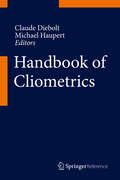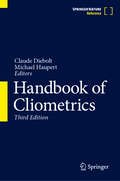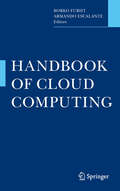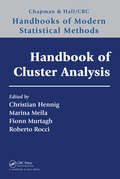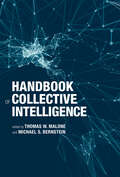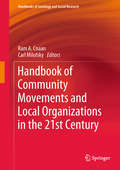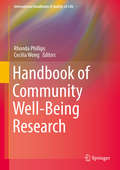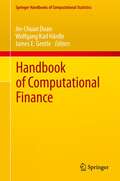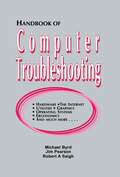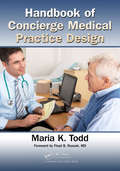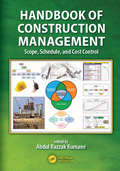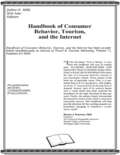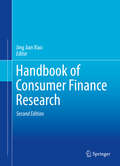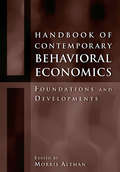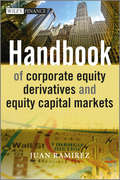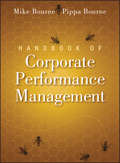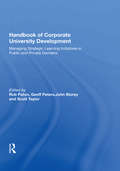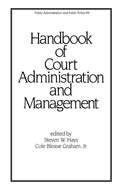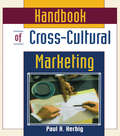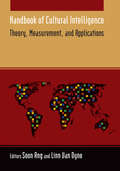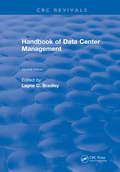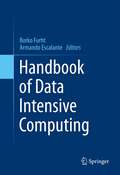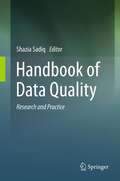- Table View
- List View
Handbook of Cliometrics
by Claude Diebolt Michael HaupertThe Handbook of Cliometrics is a milestone in the field of historical economics and econometric history through its emphasis on the concrete contribution of cliometrics to our knowledge in economics and history. The articles in the handbook authored by the leading scholars in the fields, stress the usefulness of cliometrics for economists, historians and social scientists in general. The Handbook offers a comprehensive coverage of topics with each article providing an overview of the contributions of cliometrics to a particular topic. The Handbook sets a new standard of quality in the field by offering a world-wide forum of discussion in cliometrics.
Handbook of Cliometrics
by Claude Diebolt Michael HaupertThis handbook is a milestone in the field of historical economics and econometric history through its emphasis on the concrete contribution of cliometrics to our knowledge in economics and history. The articles in the handbook authored by the leading scholars in the fields, stress the usefulness of cliometrics for economists, historians and social scientists in general. The handbook offers a comprehensive coverage of topics with each article providing an overview of the contributions of cliometrics to a particular topic. The handbook has set a new standard of quality in the field by offering a world-wide forum of discussion in cliometrics. This updated and extended third edition of the handbook of cliometrics offers a substantially enlarged collection of articles and thus stresses its unique position as authoritative reference work in this field.
Handbook of Cloud Computing
by Borko Furht Armando EscalanteCloud computing has become a significant technology trend. Experts believe cloud computing is currently reshaping information technology and the IT marketplace. The advantages of using cloud computing include cost savings, speed to market, access to greater computing resources, high availability, and scalability. Handbook of Cloud Computing includes contributions from world experts in the field of cloud computing from academia, research laboratories and private industry. This book presents the systems, tools, and services of the leading providers of cloud computing; including Google, Yahoo, Amazon, IBM, and Microsoft. The basic concepts of cloud computing and cloud computing applications are also introduced. Current and future technologies applied in cloud computing are also discussed. Case studies, examples, and exercises are provided throughout. Handbook of Cloud Computing is intended for advanced-level students and researchers in computer science and electrical engineering as a reference book. This handbook is also beneficial to computer and system infrastructure designers, developers, business managers, entrepreneurs and investors within the cloud computing related industry.
Handbook of Cluster Analysis (Chapman & Hall/CRC Handbooks of Modern Statistical Methods)
by Fionn Murtagh Marina Meila Roberto Rocci Christian HennigHandbook of Cluster Analysis provides a comprehensive and unified account of the main research developments in cluster analysis. Written by active, distinguished researchers in this area, the book helps readers make informed choices of the most suitable clustering approach for their problem and make better use of existing cluster analysis tools.The
Handbook of Collective Intelligence
by Thomas W. Malone Michael S. BernsteinExperts describe the latest research in a rapidly growing multidisciplinary field, the study of groups of individuals acting collectively in ways that seem intelligent.Intelligence does not arise only in individual brains; it also arises in groups of individuals. This is collective intelligence: groups of individuals acting collectively in ways that seem intelligent. In recent years, a new kind of collective intelligence has emerged: interconnected groups of people and computers, collectively doing intelligent things. Today these groups are engaged in tasks that range from writing software to predicting the results of presidential elections. This volume reports on the latest research in the study of collective intelligence, laying out a shared set of research challenges from a variety of disciplinary and methodological perspectives. Taken together, these essays—by leading researchers from such fields as computer science, biology, economics, and psychology—lay the foundation for a new multidisciplinary field.Each essay describes the work on collective intelligence in a particular discipline—for example, economics and the study of markets; biology and research on emergent behavior in ant colonies; human-computer interaction and artificial intelligence; and cognitive psychology and the “wisdom of crowds” effect. Other areas in social science covered include social psychology, organizational theory, law, and communications.ContributorsEytan Adar, Ishani Aggarwal, Yochai Benkler, Michael S. Bernstein, Jeffrey P. Bigham, Jonathan Bragg, Deborah M. Gordon, Benjamin Mako Hill, Christopher H. Lin, Andrew W. Lo, Thomas W. Malone, Mausam, Brent Miller, Aaron Shaw, Mark Steyvers, Daniel S. Weld, Anita Williams Woolley
Handbook of Community Movements and Local Organizations in the 21st Century (Handbooks Of Sociology And Social Research Ser.)
by Ram A. Cnaan Carl MilofskyThis new handbook builds on The Handbook of Community Movements and Local Organizations published in 2007, and is the only resource defining the field of study related to small nonprofit organizations and to studying communities from the standpoint of associations that make up communities. It explores the history and conceptualizations of community, theoretical concepts in community organizations, social movements ranging from health to crime, and community practice methods. Further it provides authoritative statements of major theory areas, gives examples of different sub areas of the field, provides guidance to people working as practitioners in the field, and nicely coincides with the increasing interest in clinical sociology. This handbook is of great interest to academics, students and practitioners with an interdisciplinary resource to understand and collaborate in work with contemporary communities.
Handbook of Community Well-Being Research
by Rhonda Phillips Cecilia WongThis Handbook brings together foundational and leading-edge research exploring dimensions of improving quality of life in communities of place. Social indicators and other assessment techniques will be explored, including from the framework of community perspectives which is concerned with enhancing quality of life for community members. As part of this trans-disciplinary work, participation, engagement, and empowerment will be key concepts presented. Along with capacity building and service provision, these elements influence community well-being and will be considered along with subjective and objective assessment approaches. Researchers from around the globe share their work on this important topic of community well-being, bringing together a diverse array of disciplinary perspectives. Those working in the areas of public policy, community development, community and social psychology, urban and regional planning, and sustainable development will find this volume particularly useful for the array of approaches presented.
Handbook of Computational Finance
by Wolfgang Karl Härdle James E. Gentle Jin-Chuan DuanAny financial asset that is openly traded has a market price. Except for extreme market conditions, market price may be more or less than a "fair" value. Fair value is likely to be some complicated function of the current intrinsic value of tangible or intangible assets underlying the claim and our assessment of the characteristics of the underlying assets with respect to the expected rate of growth, future dividends, volatility, and other relevant market factors. Some of these factors that affect the price can be measured at the time of a transaction with reasonably high accuracy. Most factors, however, relate to expectations about the future and to subjective issues, such as current management, corporate policies and market environment, that could affect the future financial performance of the underlying assets. Models are thus needed to describe the stochastic factors and environment, and their implementations inevitably require computational finance tools.
Handbook of Computer Troubleshooting (Computers And The Internet Ser.)
by Jim Pearson Michael Byrd Robert A. SaighFirst published in 2001. Routledge is an imprint of Taylor & Francis, an informa company.
Handbook of Concierge Medical Practice Design
by Maria K. ToddIn concierge medicine, physicians develop amenities-rich membership programs and collect a monthly or annual membership fee to pay for the amenities in addition to the medical services rendered. Handbook of Concierge Medical Practice Design examines the many considerations physicians must make prior to transitioning their practices into concierge services. Maria K. Todd, a recognized expert in concierge medicine, branding, consulting, healthcare, marketing, medical tourism, planning, and physician practice administration, explains how to set up a concierge practice. She describes how this new business model affects workflow and outlines financial considerations including managed care payer relations, the hybrid practice, and predictive modeling to uncover the hidden factors that affect bottom-line performance. The book supplies readers with models for creating a business plan and a strategy for transforming a practice into a concierge practice. It concludes by covering the legal aspects of creating a concierge practice. It includes patient acquisition and retention strategies as well as detailed plans for adding additional doctors and physician extenders, such as nurse practitioners and physician assistants.The book provides sample employment contracts and advice on how to select and work with consultants. It includes chapters on business process re-engineering, workflow management, financial considerations, competitive analysis, developing a business plan, and how to market the new practice.
Handbook of Construction Management: Scope, Schedule, and Cost Control (Systems Innovation Book Series)
by Abdul Razzak RumaneThe book is developed to provide significant information and guidelines to construction and project management professionals (owners, designers, consultants, construction managers, project managers, supervisors, contractors, builders, developers, and many others from the construction-related industry) involved in construction projects (mainly civil construction projects, commercial-A/E projects) and construction-related industries. It covers the importance of construction management principles, procedures, concepts, methods, and tools, and their applications to various activities/components/subsystems of different phases of the life cycle of a construction project. These applications will improve the construction process in order to conveniently manage the project and make the project most qualitative, competitive, and economical. It also discuss the interaction and/or combination among some of the activities/elements of management functions, management processes, and their effective implementation and applications that are essential throughout the life cycle of project to conveniently manage the project. This handbook will: Focus on the construction management system to manage construction projects Include a number of figures and tables which will enhance reader comprehension Provide all related topics/areas of construction management Be of interest to all those involved in construction management and project management Provide information about Building Information Modeling (BIM), and ISO Certification in Construction Industry Offer a chapter on Lean construction The construction project life cycle phases and its activities/elements/subsystems are comprehensively developed and take into consideration Henri Fayol's Management Function concept which was subsequently modified by Koontz and O'Donnel and Management Processes Knowledge Areas described in PMBOK® published by Project Management Institute (PMI). The information available in the book will also prove valuable for academics/instructors to provide construction management/project management students with in-depth knowledge and guidelines followed in the construction projects and familiarize them with construction management practices.
Handbook of Consumer Behavior, Tourism, and the Internet
by Juline Mills Rob LawMake the most of your online business resources The growing acceptance and use of the Internet as an increasingly valuable travel tool has tourism and hospitality businesses taking a critical look at their business-to-customer online environments while pondering such questions as, "How do I get people to visit my Web site?" "Is my Web site attracting the &’right&’ kind of e-consumers?" and "How do I turn browsers into buyers?" The Handbook of Consumer Behavior, Tourism, and the Internet analyzes the latest strategies involving Internet business applications that will help you attract-and keep-online travel customers. Researchers from the United States, Europe, and Asia present the latest findings you need to make the right decisions regarding long-term e-commerce development and planning.The Handbook of Consumer Behavior, Tourism, and the Internet examines vital issues affecting the travel and tourism industry from an online perspective. This book analyzes the latest theory and research on general online buyer characteristics, the differences between online and offline consumer behavior, the differences between broadband and narrowband users, the online search process, quality and perception of lodging brands, and Web site design, maintenance, and development. Each section of the book includes a model/diagram that serves as an overview of the topic, followed by a thorough discussion on the topic from several sources. Each section ends with commentary on the areas where future research is needed. The book&’s contributors use a variety of research methodologies ranging from qualitative data analyses using artificial neutral network analysis, to experimental design, non-parametric statistical tests, and structural equation modeling. Topics examined in the Handbook of Consumer Behavior, Tourism, and the Internet include: the need for businesses to use internal examinations to determine and meet online consumer needs the emerging field of e-complaint behavior-consumers taking to the Web to voice complaints about travel services how to use e-tools to measure guest satisfaction how to measure consumer reaction to Web-based technology the Internet&’s impact on decision making for travel products and how to use e-mail marketing, electronic customer relationship management (eCRM), Web positioning, and search engine placementThe Handbook of Consumer Behavior, Tourism, and the Internet is equally valuable as a classroom resource or professional reference, providing up-to-date material on Internet applications and their impact on consumers and e-commerce.
Handbook of Consumer Finance Research
by Jing Jian XiaoThis second edition of the authoritative resource summarizes the state of consumer finance research across disciplines for expert findings on--and strategies for enhancing--consumers' economic health. New and revised chapters offer current research insights into familiar concepts (retirement saving, bankruptcy, marriage and finance) as well as the latest findings in emerging areas, including healthcare costs, online shopping, financial therapy, and the neuroscience behind buyer behavior. The expanded coverage also reviews economic challenges of diverse populations such as ethnic groups, youth, older adults, and entrepreneurs, reflecting the ubiquity of monetary issues and concerns. Underlying all chapters is the increasing importance of financial literacy training and other large-scale interventions in an era of economic transition. Among the topics covered: Consumer financial capability and well-being. Advancing financial literacy education using a framework for evaluation. Financial coaching: defining an emerging field. Consumer finance of low-income families. Financial parenting: promoting financial self-reliance of young consumers. Financial sustainability and personal finance education. Accessibly written for researchers and practitioners, this Second Edition of the Handbook of Consumer Finance Research will interest professionals involved in improving consumers' fiscal competence. It also makes a worthwhile text for graduate and advanced undergraduate courses in economics, family and consumer studies, and related fields.
Handbook of Contemporary Behavioral Economics: Foundations and Developments
by Morris AltmanAt a time when both scholars and the public demand explanations and answers to key economic problems that conventional approaches have failed to resolve, this groundbreaking handbook of original works by leading behavioral economists offers the first comprehensive articulation of behavioral economics theory. Borrowing from the findings of psychologists, sociologists, political scientists, legal scholars, and biologists, among others, behavioral economists find that intelligent individuals often tend not to behave as effectively or efficiently in their economic decisions as long held by conventional wisdom. The manner in which individuals actually do behave critically depends on psychological, institutional, cultural, and even biological considerations. "Handbook of Contemporary Behavioral Economics" includes coverage of such critical areas as the Economic Agent, Context and Modeling, Decision Making, Experiments and Implications, Labor Issues, Household and Family Issues, Life and Death, Taxation, Ethical Investment and Tipping, and Behavioral Law and Macroeconomics. Each contribution includes an extensive bibliography.
Handbook of Contract Management in Construction
by Ali D. HaidarThis book addresses the process and principles of contract management in construction from an international perspective. It presents a well-structured, in-depth analysis of construction law doctrines necessary to understand the fundamentals of contract management. The book begins with an introduction to contract management and contract law and formation. It then discusses the various parties to a contract and their relevant obligations, whether they are engineers, contractors or subcontractors. It also addresses standard practices when drafting and revising contracts, as well as what can be expected in standard contracts general clauses. Two chapters are dedicated to contract clauses, with one focused on contract administration such as schedules, payment certificates and defects liability, and the other focused on contract management, such as terminations, dispute resolutions and claims. This book provides a useful reference to engineers, project managers and students within the field of engineering and construction management.
Handbook of Corporate Equity Derivatives and Equity Capital Markets
by Juan RamirezEquity strategies are closely guarded secrets and as such, there is very little written about how investors and corporate can utilise equity vehicles as part of their growth strategies. In this much-needed book, industry expert Juan Ramiraz guides readers through the whole range of equity derivative instruments, showing how they can be applied to a range of equity capital market situations, including hedging, yield enhancement and disposal of strategic stakes, mergers and acquisitions, stock options plan hedging, equity financings, share buybacks and other transactions on treasury shares, bank regulatory capital arbitrage and tax driven situations. The book includes case studies to highlight how equity derivative strategies have been used in real-life situations.
Handbook of Corporate Performance Management
by Pippa Bourne Mike BourneA corporate performance management system can transform your business - but only if it is designed and implemented in the right way. this book will provide you with the tools and approaches to help translate your strategy into action and make you aware of the pitfalls to be avoided.The Handbook of Corporate Performance Management takes a practical approach, offering guidance on what works, tools to use, and how leadership makes an essential contribution to success.THE BOOK IS BROADLY DIVIDED INTO FOUR SECTIONS:Section One Provides the essential toolkit for setting up and implementing a corporate performance management system. It covers the processes and approaches you need to make it work.Section two explains how you can use performance management to manage your business from tracking performance through the management review process to checking whether your strategy is still appropriate.Section three provides guidance for measuring specific key areas; financial performance, staff performance, customers, processes, competence and resource development, and sustainability.Section four is about bringing it all together. Case studies of individuals from widely differing organisations, who have all delivered great results, illustrate the importance of good leadership in creating a culture of high performance.The Handbook of Corporate Performance Management is the essential guide to using performance measurement and management to get the best out of your business.
Handbook of Corporate University Development: Managing Strategic Learning Initiatives in Public and Private Domains
by Geoff PetersFrom the moment the first corporate university (CU) was created and the term was coined, the central metaphor of university has proved a double-edged sword. The emphasis on university has been a driving force in moving companies beyond a restricted and siloed approach to training, to a central vision for learning within the organization. On the other hand, there have been failures and many corporate universities have struggled to bring a business rigour to learning or to align their development with the key business and financial drivers of the organization. Handbook of Corporate University Development draws on experience from around the world, to provide anyone responsible for strategy and learning - at senior levels in government, education and business - with a picture of current best practice. The Handbook is not a prescriptive 'how-to', rather an exploration of key issues such as: � Who owns a corporate university initiative? � How is the funding managed? � How is the CU aligned with business strategy? � How do CU directors and project managers deploy resources? � How do they deal with suppliers? � How do they report and measure CU performance? � What are the processes and technologies needed to provide and support different forms of learning? � How can you blend different media? � How do you assess what learning has taken place? � What are the future prospects and potential for corporate universities? It is time for the corporate university to demonstrate how business rigour, handled deftly and with strong and perceptive leadership, can revolutionize learning both inside and outside the organization. Handbook of Corporate University Development is an important catalyst towards this process.
Handbook of Court Administration and Management (Public Administration And Public Policy Ser. #49)
by HaysBlending both the theoretical and applied aspects of contemporary issues in court management, this reference/text offers in-depth coverage of all major topics and developments in judicial systems administration. It is suitable for use in the classroom or for self-study.;Providing the background material to clarify even the most technical management application, this book: presents the history and theory of the court management movement; examines the separation of powers doctrine, and its relationship to judicial independence; discusses the latest developments in court reform, the American Bar Association standards, alternative dispute resolution techniques and caseflow considerations; analyzes unified court budgeting and revenue generation by judicial systems; describes personnel administration, training and jury management; and elucidates court performance evaluation, planning approaches, the use of cameras in the courtroom and audio-visual applications.
Handbook of Critical Incident Analysis
by Richard W SchwesterCritical incidents all too often explode onto the social conscious and challenge our sense of security. This comprehensive handbook brings together a range of experts who provide a foundation for the field of critical incident analysis by examining specific incidents9/11, the Virginia Tech massacre, the H1N1 pandemic, the BP oil spill, and more--through various methodological and disciplinary lenses.
Handbook of Cross-Cultural Marketing
by Erdener Kaynak Paul HerbigGoing global can be risky business if you don't divest yourself of your ethnocentric thinking. You have to take into consideration your new market's language, work schedules, tastes, lifestyle choices, and cultural associations, and this is the book to help you do that! Handbook of Cross-Cultural Marketing shows you how to sensitize your marketing approaches to the cultural norms and taboos of other societies, as well as the importance of demonstrating an interest in and appreciation of different cultures.Designed to assist both American and foreign companies, Handbook of Cross-Cultural Marketing shows you how to increase your chance at success in international markets. It identifies and explains ten important aspects of culture that are essential to cross-cultural marketing to help you understand how underlying cultural beliefs govern the way marketing functions in different societies. It also gives you specific steps for developing cultural adaptation strategies in international marketing. To further your understanding of global marketing and fundamental marketing concepts, this comprehensive book discusses:real life examples of company successes and failures abroadattitudes toward middlemen in underdeveloped countriesthe advantages of foreign trade showslocating and using representatives, agents, and/or distributors in foreign countriesthe reception of different American products in different countriespotential cultural pitfalls of primary data collecting techniquesthe role of time in various culturessetting standards for product performanceA useful text for students and practitioners alike, Handbook of Cross-Cultural Marketing gives you hands-on strategies and advice for delving into different markets, using techniques that are respectful of individual cultures, and avoiding unnecessary mistakes that can occur if you don't take the initiative to get to know the culture of your new marketplace. Your outlook and beliefs are not the global norm, so read this book to find out how you can be successful with customers who are different from you in terms of motivation, values, beliefs, and outlook.
Handbook of Cultural Intelligence: Theory, Measurement, and Applications
by Soon Ang Linn Van DyneCultural intelligence is defined as an individual's ability to function effectively in situations characterized by cultural diversity. With contributions from eminent scholars worldwide, the "Handbook of Cultural Intelligence" is a 'state-of-the-science' summary of the body of knowledge about cultural intelligence and its relevance for managing diversity both within and across cultures. Because cultural intelligence capabilities can be enhanced through education and experience, this handbook emphasizes individual capabilities - specific characteristics that allow people to function effectively in culturally diverse settings - rather than the approach used by more traditional books of describing and comparing cultures based on national cultural norms, beliefs, habits, and practices.The Handbook covers conceptional and definitional issues, assessment approaches, and application of cultural intelligence in the domains of international and cross-cultural management as well as management of domestic activity. It is an invaluable resource that will stimulate and guide future research on this important topic and its application across a broad range of disciplines, including management, organizational behavior, industrial and organizational psychology, intercultural communication, and more.
Handbook of Data Center Management: Second Edition (CRC Press Revivals)
by Layne C. BradleyAccounting for the rapid and often confusing changes currently underway in the information systems of organizations, such as the rush to replace mainframes with networks and the decentralization of data storage and processing, provides insights on the duties and challenges of a data center manager. Covers strategic planning, management practices, controls, systems and contingency planning, network technology, human resources, desktop computing, and future directions....
Handbook of Data Intensive Computing
by Borko Furht Armando EscalanteData Intensive Computing refers to capturing, managing, analyzing, and understanding data at volumes and rates that push the frontiers of current technologies. The challenge of data intensive computing is to provide the hardware architectures and related software systems and techniques which are capable of transforming ultra-large data into valuable knowledge. Handbook of Data Intensive Computing is written by leading international experts in the field. Experts from academia, research laboratories and private industry address both theory and application. Data intensive computing demands a fundamentally different set of principles than mainstream computing. Data-intensive applications typically are well suited for large-scale parallelism over the data and also require an extremely high degree of fault-tolerance, reliability, and availability. Real-world examples are provided throughout the book. Handbook of Data Intensive Computing is designed as a reference for practitioners and researchers, including programmers, computer and system infrastructure designers, and developers. This book can also be beneficial for business managers, entrepreneurs, and investors.
Handbook of Data Quality: Research and Practice
by Shazia SadiqThe issue of data quality is as old as data itself. However, the proliferation of diverse, large-scale and often publically available data on the Web has increased the risk of poor data quality and misleading data interpretations. On the other hand, data is now exposed at a much more strategic level e.g. through business intelligence systems, increasing manifold the stakes involved for individuals, corporations as well as government agencies. There, the lack of knowledge about data accuracy, currency or completeness can have erroneous and even catastrophic results. With these changes, traditional approaches to data management in general, and data quality control specifically, are challenged. There is an evident need to incorporate data quality considerations into the whole data cycle, encompassing managerial/governance as well as technical aspects. Data quality experts from research and industry agree that a unified framework for data quality management should bring together organizational, architectural and computational approaches. Accordingly, Sadiq structured this handbook in four parts: Part I is on organizational solutions, i.e. the development of data quality objectives for the organization, and the development of strategies to establish roles, processes, policies, and standards required to manage and ensure data quality. Part II, on architectural solutions, covers the technology landscape required to deploy developed data quality management processes, standards and policies. Part III, on computational solutions, presents effective and efficient tools and techniques related to record linkage, lineage and provenance, data uncertainty, and advanced integrity constraints. Finally, Part IV is devoted to case studies of successful data quality initiatives that highlight the various aspects of data quality in action. The individual chapters present both an overview of the respective topic in terms of historical research and/or practice and state of the art, as well as specific techniques, methodologies and frameworks developed by the individual contributors. Researchers and students of computer science, information systems, or business management as well as data professionals and practitioners will benefit most from this handbook by not only focusing on the various sections relevant to their research area or particular practical work, but by also studying chapters that they may initially consider not to be directly relevant to them, as there they will learn about new perspectives and approaches.
